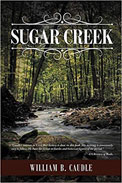
 |
Jem Thorsby is a captain in the Confederate Army. Wounded outside Jonesborough, Georgia, he is pulled from the battle by an old friend, Sergeant Levy. Levy is a free black man from Florida fighting for the Confederacy after Union troops killed his family. Once recuperated from his wounds, Jem, with Levy at his side, is given command of a small company of men and charged with helping the Confederates push against the Union forces around Tennessee during the last years of the Civil War. Levy is a valuable asset, helping Jem prepare his ill-equipped men for battle. However, being a freed black man in the South, Levy often runs up against racism. Undaunted, Levy continues by Jem's side. As an ordained elder in the Mormon church, Levy often prays for Jem and talks to him about his faith, as well. Battle, injuries, and prejudice will test these men's unwavering love for and loyalty to each other.
Caudle's interest in Civil War history is clear in this book. His writing is consistently easy to follow. He bases his fiction on battles and historical figures of the period, which he references in an included appendix. The book's atmosphere, setting, and tone feel authentic and well-researched. Civil War buffs, particularly those interested in the battle sites of the conflict, will find plenty of geographical data to trace on historical maps of Civil War battles. The theme of this book is clearly the friendship between these two men fighting for the Confederate Army. Both men disdain slavery but believe in a state's rights and feel threatened by the Union. It's not uncommon for war books to explore the causes of war and the character's reasons to be involved, especially in books covering the Civil War and the Vietnam War. For example, Joseph Heller's Catch-22 partially focuses on uncovering the absurdities of war in general. In Caudle's work, Levy's reasons for fighting for the Confederacy are clearly explained. However, considering the larger context and the racism Levy experiences, there is a certain similar feeling of conflicting causes.
The book includes a lot of marching and waiting, as is common in the military, but the majority of most battles take place behind the scenes. Books like Stephen Cranes' classic, The Red Badge of Courage, and Shiloh by Shelby Foote paint intense battle scenes. The purpose of those depictions is not to glorify war but to show the real depth of the characters in their most stressful moments. In those moments, the characters' courage and fear, their bravest and basest emotions are laid bare. With Caudle's work, we are led to those moments and then whisked past them to the recuperation of our characters. The reader is told they fought bravely and honorably and then shown that no matter how confusing and overwhelming the din and chaos of battle, Levy always manages to find an injured Jem and bring him to safety. These events would have had more impact if the reader could have experienced them with the characters. However, the men's friendship is admirable, and, ultimately, Levy's loyalty and belief system win Jem over to his faith. The focus of this novel is more on the men's ability to respect and honor each other despite their differences rather than a harrowing account of the battles fought. And in this respect, it succeeds.